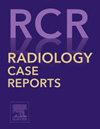Treatment-resistant Cushing disease and acromegaly in a young woman: A case of functional pituitary macroadenoma
Q4 Medicine
引用次数: 0
Abstract
Cushing disease and acromegaly are common endocrine disorders caused by excessive cortisol and growth hormone production, respectively. Both conditions can co-occur due to functioning pituitary adenomas, which are typically benign pituitary gland tumors. This report discusses a 30-year-old woman with hyperpituitarism leading to treatment-resistant Cushing disease and acromegaly caused by a functional pituitary macroadenoma. A 30-year-old woman presented with a history of excessive weight gain, facial puffiness, fatigue, persistent headaches, and visual disturbances. Clinical examination revealed features consistent with Cushing disease and acromegaly, including a moon face, central obesity, and large hands and feet—the ophthalmologic evaluation identified bitemporal hemianopia, suggesting optic chiasm compression. Laboratory results showed elevated ACTH, IGF-1, and prolactin levels, alongside confirmed hypercortisolism. The patient also had secondary diabetes mellitus and galactorrhea—initial treatment with octreotide provided limited benefit, with persistent hormone elevations and insufficient symptom control. The patient underwent endonasal endoscopic transsphenoidal resection of the pituitary macroadenoma, leading to marked symptomatic and hormonal improvements. This underscores the diagnostic challenge and treatment complexity of such cases. Early diagnosis is critical for optimizing outcomes in patients with hyperpituitarism and mitigating complications. This case highlights the importance of multidisciplinary management and the necessity of long-term follow-up to monitor for recurrence and ensure sustained remission.
求助全文
约1分钟内获得全文
求助全文
来源期刊

Radiology Case Reports
Medicine-Radiology, Nuclear Medicine and Imaging
CiteScore
1.10
自引率
0.00%
发文量
1074
审稿时长
30 days
期刊介绍:
The content of this journal is exclusively case reports that feature diagnostic imaging. Categories in which case reports can be placed include the musculoskeletal system, spine, central nervous system, head and neck, cardiovascular, chest, gastrointestinal, genitourinary, multisystem, pediatric, emergency, women''s imaging, oncologic, normal variants, medical devices, foreign bodies, interventional radiology, nuclear medicine, molecular imaging, ultrasonography, imaging artifacts, forensic, anthropological, and medical-legal. Articles must be well-documented and include a review of the appropriate literature.
 求助内容:
求助内容: 应助结果提醒方式:
应助结果提醒方式:


